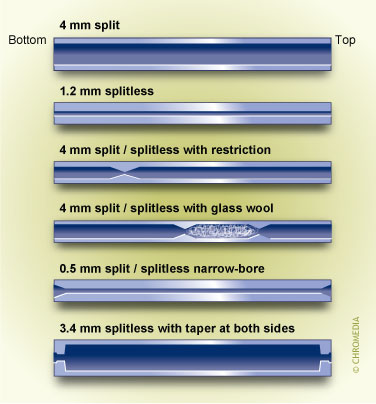Abstract Since the injector is the first point of contact – and often most critical – between sample and the GC system, it has been called the Achilles Heel of GC. It can operate reliably, but it can also operate badly! Implement a good maintenance routine for your injector. Replace injector liners regularly, with appropriately deactivated liners as necessary. Regularly replace septa, with the proper septum type. Keep records to be able to evaluate the performance of the system over time.
LevelBasic
Split and splitless injectors are equipped with liners to provide an inert surface within the injector to facilitate sample vaporisation. The mixture of vaporized solvent and liquid droplets that are ejected out of the syringe as a result of the explosion-like evaporation process, has to evaporate, homogeneously mixed and either transported onto the column, or split between column and split-exit. This entire process has to take place within seconds and places stringent requirements on the selection of an appropriate liner.
| Important requirements for liners:
|
Liners are available in a variety of designs, in a range of sizes often for use with a specific type/model of injector from various instrument manufacturers. Some of the liners are intended for split operation only, while others are for use in splitless and direct injection. In all cases it is important to install the capillary column according to the manufacturer's recommendations.
In case of split injection it is important that the sample is homogeneously mixed with carrier gas before transfer to the column inlet. This is best achieved by using a wide-bore open liner or a liner packed with glass wool or containing a frit to stimulate mixing. This packing also provides an effective barrier against dirt or dust. A drawback is that thermally labile analytes might decompose on active sites on the packing.
In splitless injection, in contrast, mixing of the sample vapor with carrier gas should be surpressed. This is to facilitate recondensation of the solvent in the column inlet, which is required to obtain a good solvent effect. For this reason, a narrow, empty liner is recommended for splitless injections.
For specific applications, liners containing 'obstacles' such as glass wool, a glass frit or glass beads are used.
| Liner type | Use for ... | Do not use for ...
|
| Narrow empty liners | Splitless injection | Splitless injection of more than 2 microliter |
| Wide-bore empty liners | Split injection | |
| Packed liners (glass wool) |
Dirty samples,
high-boiling samples or analytes | Thermally labile or adsorptive compounds, splitless injection |
| Liners witrh glass obstacles | Dirty samples, if packed liners give adsorption or degradation | Splitless injection, very labile analytes |
Choice of liner volume depends on several parameters. Not all solvents will expand to the same volume under a given set of conditions:
- If the injection volume is too high, flashback of the sample may occur. This means that the vapour can expand beyond the volume of the liner, causing
 contamination of the purge lines and giving rise to severe memory effects, erratic quantitation, ghost peaks and peak tailing.
contamination of the purge lines and giving rise to severe memory effects, erratic quantitation, ghost peaks and peak tailing. - If the volume of the liner is too large, excessive band broadening will occur, resulting in less separation efficiency.
- The most ideal internal diameter of a liner is 1 - 3 mm. The shape of the liner must be such that there are no dead angles and volumes, which affect the efficiency negatively.
- Neither should the shape give rise to different flow profiles of the carrier gas.
The use of glass wool or other packings in the liner has several functions:
- Improving the evaporation process of the sample at a hot surface
- Better mixing of sample vapour and carrier gas resulting in a better repeatability between injections and better quantitative analysis
- Provides a larger surface area which promotes the vaporization of the samples
- Acts as a trap to collect non-volatile residues in the sample protecting the capillary column from dirty samples
- Prevents sample hitting the bottom of the injector before vaporization
A negative effect of the presence of glass wool or other additional surfaces is the possible adsorption or even degradation of compounds at the hot surface. Therefore pre-treated (silanised) glass wool must always be used in the liner. The position of this material in the liner is also important.
Different types of liners
Tapering of the bottom minimizes the contact of the analytes with the bottom of the injection port. This is especially important in the splitless injection mode, because the residence time of the sample in the liner is longer.
| Narrow internal of the liner |
Another important consideration is the condition of the liner. This is the sample entry point, operated at relatively high temperatures and so it quickly becomes contaminated with non-volatile matter arising from sample degradation or from material already present. These contaminants inevitably accumulate inside the liner and cause a loss of column performance, usually in the form of peak distortion. It is essential to monitor the liner condition regularly and to either clean or replace it from time to time. A further problem can develop from worn septa due to fragments falling into the liner which can cause a sudden deterioration of peak shape.
Since for quantitative analysis we compare standards with samples, if injector performance varies for samples and standards, then the basis for quantitation is lost. This can be of concern if presence of sample matrix causes different injection performance for transfer of solute to the column (it is not unknown for matrix to increase the solute transfer to the column!).
 Did you ever try to explain separation to your employees or students? Well, try no more: Lee Polite did it for you in a way which is hard to beat. We will open up one example of his whiteboard class.
Did you ever try to explain separation to your employees or students? Well, try no more: Lee Polite did it for you in a way which is hard to beat. We will open up one example of his whiteboard class. 




